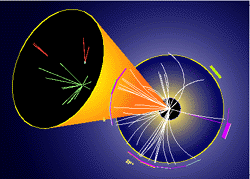Why Now?

For cosmologists the old Chinese curse, “May you live in interesting times,” is beginning to seem all too appropriate. According to the latest evidence, a mysterious “antigravity” force–the so-called dark energy–appears to be a major component of the cosmos. The dark energy density is thought to remain constant in time, while matter continues to be “diluted” as the Universe expands. That raises a question: Why do we happen to live in the “interesting times” when the density of dark energy and that of matter happen to be similar, when one is not overwhelmed by the other? That’s the riddle a team of theorists have tackled in the 14 November PRL, and they claim to have found a simple explanation involving only the most basic parameters from high energy physics.
The team, led by Nima Arkani-Hamed of the University of California at Berkeley, focuses on two key energy scales: the so-called Planck mass ~ GeV, at which quantum gravity effects become important, and the electroweak mass ~ GeV, characteristic of the energy at which the electromagnetic and weak interactions become unified. They start by noting that these two mass scales can be combined to produce a roughly accurate value for the dark energy density: ( (Energy density has units of in this system.) Using supersymmetry and other particle physics concepts, they sketch out some ideas for why these two fundamental parameters might be so easily related to the dark energy density.
They then point out another apparent coincidence: the similarity between the matter density of the Universe and a third important cosmological parameter, the energy density of heat radiation. Most of the matter in the Universe is thought to be dark matter, but despite its mysterious nature, cosmologists believe they understand in general terms how the density of all matter evolves as the Universe expands and cools. Using the century-old Stefan-Boltzmann law, which relates temperature to the corresponding amount of radiation, Arkani-Hamed and his colleagues estimated the temperature of the Universe at which the amounts of matter and radiation should coincide. Arkani-Hamed explains that the result is about which works out to 10 K, close to the Universe’s current temperature.
According to the Stefan-Boltzmann law, at that temperature the matter and radiation energy densities are ( the formula the team found gives roughly the correct value for the dark energy density. In other words, we should now be living at a time when the energy density of radiation, dark matter, and dark energy should all coincide, just as the observations suggest.
The result is a bold assault on a deep mystery, says Joe Lykken, of the Fermi National Accelerator Laboratory near Chicago: “This apparent triple coincidence is certainly an important puzzle in modern cosmology, and if the relation is true, it does indeed explain the coincidence in a deep way.” Lykken adds, however, that the rough derivations of Arkani-Hamed and his colleagues are based on toy models. “The only way to prove their conjecture is to discover and verify some big, new, beyond-the-standard-model theory that has the desired properties.” Arkani-Hamed agrees, but adds, “These coincidences are puzzling, and it’s time to take them seriously–they may be giving us a clue towards such a theory.”
–Robert Matthews
Robert Matthews is science correspondent for the Sunday Telegraph, London, UK.


